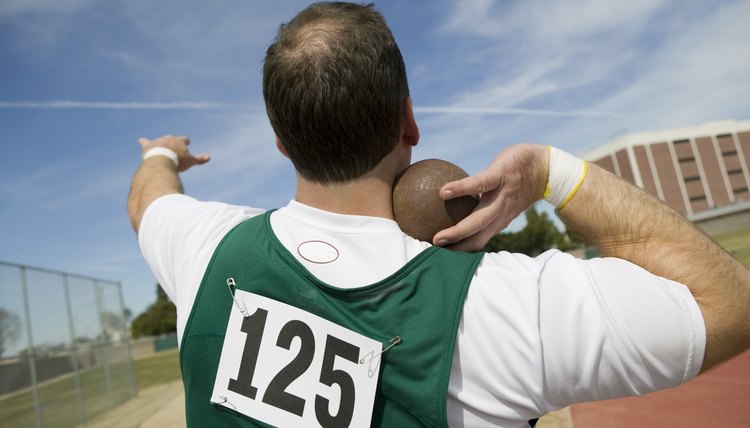Shotput Information

Shot put is an athletic throwing event that has been included each year in the modern Olympic games since their inception in 1896. Competitors push and throw a heavy metal ball called the shot as far as possible using only one hand. The winner is the athlete who puts the shot the farthest from the front marker of the throwing circle.
Origins
Early versions of the shot put can be traced to the 13th century Swill stone toss, and to traditional Scottish Highland games. The original Swiss and Scottish athletes used round stones of various weights and sizes. During the mid 1800s, the British army began using cannonballs for shot instead of stones. Inspired by the British, modern shot putters now use brass or iron balls of a specific weight for each athletic class.
Shot Put Competition
Shot put is performed from within a concrete throwing circle measuring seven feet in diameter with a four-inch high stop board across the front of the circle. Athletes can use the whole of the circle but must not touch the ground on the other side of the stop board with either foot, or their put will be deemed foul. Shot putters take turns to compete and normally are allowed six attempts per match. Shot put events take place outdoors and indoors, with the only real difference being that indoor shots are constructed in such as way as to not damage the floor when they land.
The Glide Style
The glide is the original technique used in shot putting and is the style most young athletes learn when they start training. When learning the shot, athletes may stand at the front of the throwing circle and put the shot without any additional momentum from their legs. Although this technique will reduce the distance, it allows the athlete to develop consistency while learning more complicated techniques. Once an athlete has developed good throwing technique, he or she will learn the glide, which involves standing with your back to the stop board at the far edge of the throwing circle, lowering into a squat position, and lunging backward across the circle with one foot. The athlete uses his or her legs to generate upward momentum before releasing the shot from shoulder height.
The Spin Style
The spin, introduced by the Russian shot putter Aleksandr Baryshnikov in 1972, is a more technically challenging technique and stems from discuss throwing. Athletes rotate across the circle at high speeds to generate momentum before putting the shot. With both putting techniques, the aim is to drive the shot up and out of the circle at an angle of 40 degrees, the optimum trajectory for producing the greatest distances. The spin is the most popular putting style in international competition since it generally produces the longest puts, but the glide is still used by some senior competitors at a high level.
Weights and Records
Shots come in a variety of weights. Senior men use a 16 pound shot and senior women use an 8.82 pound shot. Juniors use shots between 4.4 and 13.2 pounds, depending on age and gender. The current senior world records in the shot are 23.12 meters (75.85 feet) for men, set by American Randy Barnes in 1990, and 22.63 meters (74.25 feet) for women, set by Russian Natalya Lisovskaya in 1987.
References
Writer Bio
Patrick Dale is an experienced writer who has written for a plethora of international publications. A lecturer and trainer of trainers, he is a contributor to "Ultra-FIT" magazine and has been involved in fitness for more than 22 years. He authored the books "Military Fitness", "Live Long, Live Strong" and "No Gym? No Problem!" and served in the Royal Marines for five years.
